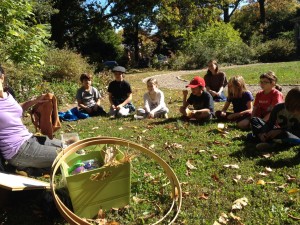Emergent Curriculum in Monkeyland
It is exciting to lay out plans each summer for a new year of learning: integrating curriculum across subject areas, working art and cooking and math into social studies units, imagining how it all might unfold month-to-month. Yet the greater excite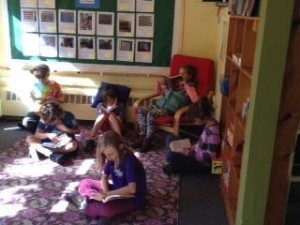 ment of being a teacher at Miquon might be when the ideas I had in August get beautifully tossed around as they come into contact with a roomful of curious children, and they take off running with projects sparked by our studies. I had in mind, for example, that we would have a whole month here in October to explore the daily life of the Lenni Lenape people who first settled this region. Then, in November, we would use our newly
ment of being a teacher at Miquon might be when the ideas I had in August get beautifully tossed around as they come into contact with a roomful of curious children, and they take off running with projects sparked by our studies. I had in mind, for example, that we would have a whole month here in October to explore the daily life of the Lenni Lenape people who first settled this region. Then, in November, we would use our newly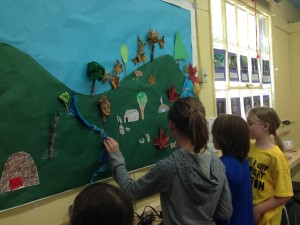 -acquired knowledge to begin to build a miniature Lenape village or maybe construct traditional shelters together outside.
-acquired knowledge to begin to build a miniature Lenape village or maybe construct traditional shelters together outside.
Instead, just as we had begun the first week of our study through books, drawings, read-alouds, documentaries, and artifacts, the children came in one day at Choice time to ask if they could borrow tools from science to cut down some long bamboo. Why? Oh, for the Lenape villa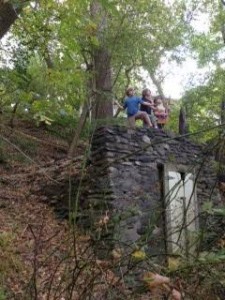 ge the group was building together across the creek in Monkeyland, of course! No need to wait until November; imaginations were already sparked and there was no time like the present to braid grasses into ropes, crush acorns and hazelnuts for br
ge the group was building together across the creek in Monkeyland, of course! No need to wait until November; imaginations were already sparked and there was no time like the present to braid grasses into ropes, crush acorns and hazelnuts for br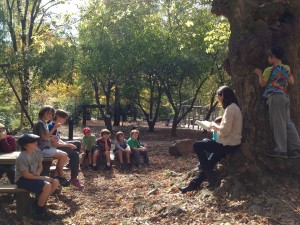 eakfast mash, or experiment with building methods.
eakfast mash, or experiment with building methods.
One of our tenets at Miquon, part of our identity as a Progressive school, is that “children’s curiosity and initiative are integral to their education.” Day to day, this means that we give space for the children’s questions and support their ideas when it comes to projects which they feel inspired to take on, individually or collectively. The idea of emergent curriculum means that curriculum development is a dynamic, organic process. It intentionally includes the interaction between teacher guidance and students’ interest and passions.
So if you are on campus these days at Choice or Theme time, you might see our 4th graders at work building a wigwam with the bamboo we harvested, playing musical instruments they have fashioned from reeds and seed pods, or selecting the perfect stone points to fashion a tool. This week the children will begin keeping journals as they imagine themselves as a child in a Lenape village (taking liberties here, as Unami, the language used among the 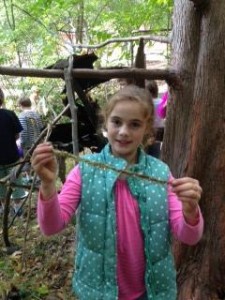 Lenape, was oral rather than written). They also had the opportunity to visit Awbury Arboretum to study the many uses of plants in Lenape culture, so I imagine they will incorporate this new information into their work and play.
Lenape, was oral rather than written). They also had the opportunity to visit Awbury Arboretum to study the many uses of plants in Lenape culture, so I imagine they will incorporate this new information into their work and play.
The enthusiasm the children are showing for this project is infectious, and it comes back inside with them to the classroom where they 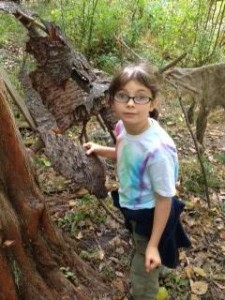 bring questions to research. They ask, How did they know which berries were poisonous? When did people start to ride horses? How big was a canoe? These questions are sparked by play but are incorporated into a sense that history and culture are alive and exciting to explore. We used the shelter as a chance to teach that the bamboo itself is not a Native species, and hardwood tree saplings which would have been more traditional, but in this case it was be better to help cull this invasive plant on Miquon’s campus, and make use of its bendable qualities.
bring questions to research. They ask, How did they know which berries were poisonous? When did people start to ride horses? How big was a canoe? These questions are sparked by play but are incorporated into a sense that history and culture are alive and exciting to explore. We used the shelter as a chance to teach that the bamboo itself is not a Native species, and hardwood tree saplings which would have been more traditional, but in this case it was be better to help cull this invasive plant on Miquon’s campus, and make use of its bendable qualities.
We will be able able to overlap with pottery work in the art ro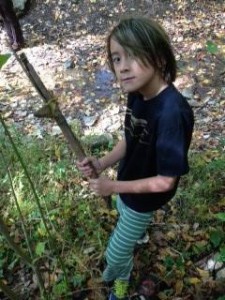 om, plant studies in science, practice on percussion and wind instruments in the classroom, and play lacrosse during P.E. As winter comes we will be ready to ask other questions, about what took place when the European settlers arrived, and the ways in which Native culture was impacted. The children’s deep immersion in the play of the village they created will prepare them well for exploring the difficult events that took place during the colonial period.
om, plant studies in science, practice on percussion and wind instruments in the classroom, and play lacrosse during P.E. As winter comes we will be ready to ask other questions, about what took place when the European settlers arrived, and the ways in which Native culture was impacted. The children’s deep immersion in the play of the village they created will prepare them well for exploring the difficult events that took place during the colonial period.
